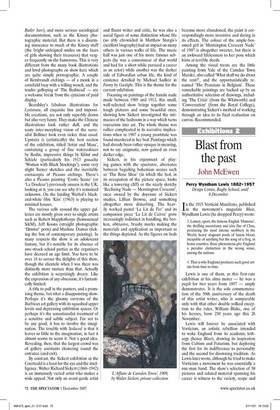Blast from the past
John McEwen Percy Wyndham Lewis 1882-1957 Design Centre, Rugby School, until 8 December In the 1915 Vorticist Manifesto, published in the movement's magazine Blast, Wyndham Lewis (he dropped Percy) wrote: 3. Luxury, sport, the famous English 'Humour', the thrilling ascendancy and idee fixe of Class, producing the most intense snobbery in the World; heavy stagnant pools of Saxon blood, incapable of anything but the song of a frog, in home counties: these phenomena give England a peculiar distinction in the wrong sense, among the nations.
4. That is why England produces such good artists from time to time.
Lewis is one of them, as this first-rate exhibition at his alma mater — he was a pupil for two years from 1897 — amply demonstrates. It is the sole commemoration of the 50th anniversary of the death of this artist writer, who is comparable only with that other double-yolked exception to the rules, William Blake, one of his heroes, born 250 years ago this 28 November.
Lewis will forever be associated with Vorticism, an artistic rebellion intended to wake England from its academic lethargy (hence Blast), drawing its inspiration from Cubism and Futurism, but deploring the first for its indifference to personality and the second for disowning tradition. As Lewis later wrote, although he tried to make Vorticism a movement he was essentially a one-man band. The show's selection of 50 pictures and related material spanning his career is witness to the variety, scope and depth of an extraordinary and sustained imaginative energy.
There are famous examples from each phase of his evolution. The early tinted drawing 'Self-Portrait' 1911, hinting at the dynamic vorticism to come; the oil of his wife, 'Red Portrait' 1937, from the Courtauld; some brilliant drawings, portraits (the best done in England since Holbein?) and nudes; the watercolour 'Bathing Scene' 1938, recalling his description of a Max Ernst, 'two disintegrated figures in frenzied conjugation'; mechanical figures, bird figures, musicalinstrument figures, which seem to have inspired the designers of recent sci-fi films; bitingly funny caricatures and satires; a charged desert landscape. Only two works belong to Rugby.
Also displayed are some books and magazines, among them his notorious satirical novel of the London art world Apes of God, with its original Lewis-designed dust-jacket, and Blast, whose puce cover and dynamic typography still startle. They are a reminder that Lewis is just as remarkable a writer (novelist, philosopher, critic) as he is a painter and draughtsman. He thought this but so did his peers.
Sickert said Lewis was `the greatest portraitist who ever lived'. IS. Eliot called him 'the most fascinating personality of our time' and for Pound he was 'the man who was wrong about everything except the superiority of live mind to dead mind; for which basic verity God bless his holy name'.
Lewis's art has a reputation for mechanical hardness, but one is disarmed by the imaginative power, wealth of information and association, technical delicacy. Reminded too of the debt of younger artists, from Paul Nash, Sutherland and Bacon (Lewis wrote the first review) to that fiercely vorticist spirit Michael Sandle, who has splendidly and publicly blasted the current much-hyped 'art' flux as 'a blizzard of shite'. Above all, the work looks wonderfully fresh and undated, the ultimate endorsement of Lewis's teasing, troublemaking individualism. As he wrote: 'I am all in favour of a young man behaving rudely to everyone in sight. This may not be good for the young man, but it's good for everyone else.' It was something he practised with style but to his penurious cost. Lewis never knew where his next glass of champagne was coming from, Cy Fox, most devoted guardian of the sacred flame, has commented. To meet he was apparently genial and not at all forbidding.
Lewis remains too various to categorise, too politically incorrect, too much trouble for the historical mainstream. Having said which there will be a show of his portraits at the National Portrait Gallery next summer.
Rugby's lads and lasses (50 per cent these co-ed days) should also consider that this most electrifying alumnus was bottom of the class but, to their school's credit, was soon advised to move on and do what he did best which, as their fine tribute celebrates, he triumphantly did.






































































 Previous page
Previous page